Scottish Health Survey - topic report: mental health and wellbeing
The Scottish Health Survey (SHeS) provides information on the health and factors relating to the health of people living in Scotland that cannot be obtained from other sources. This topic report is secondary analysis of the 2012 and 2013 surveys, exploring factors associated with the mental health and wellbeing of adults aged 16 years and older.
This document is part of a collection
4. Demographic factors
4.1 Factors associated with low mental wellbeing
This section includes analysis of WEMWBS and GHQ12 scores for demographic factors identified in the literature review. Factors which are associated with below average WEMWBS scores or GHQ12 scores of four or higher are shown in Table 4A. These variables were selected for inclusion in the regression analyses in this chapter.
Socio-demographic factors, 2012/2013
| WEMWBS | GHQ12 | |
|---|---|---|
| Age | Y | Y |
| Marital status | Y | Y |
| Area deprivation | Y | |
| Economic activity | Y | Y |
| Parental socio-economic classification | Y | |
| Equivalised household income | Y | Y |
| Unpaid caring | Y | Y |
4.1.1 Age and Gender
There are minor differences between men and women in relation to both WEMWBS and GHQ12 scores.
In 2012/2013, the mean WEMWBS score for men was 50.3, while for women it was 49.6.
Although data from two years of survey data cannot be used to describe changes within age cohorts, the pattern of WEMWBS scores by age group closely matches the life satisfaction scale in an analysis of the British Household Panel Study[1]. Mean scores are high in the youngest adult age groups (50.1 and 50.2 for ages 16-24 and 25-34 respectively), then drop among adults aged 45-54 (48.9), rise to a peak between ages 65 and 74 (51.1), then drop off again among the oldest group (ages 75+, mean score 49.5). Mean WEMWBS scores were higher among men than women across all age groups.
Figure 4A
WEMWBS mean scores, by age group and sex, 2012/2013
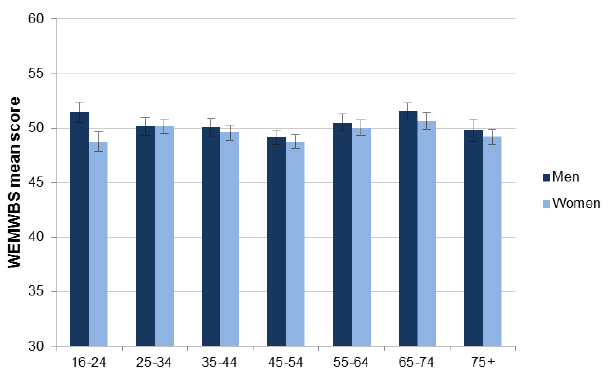
Fewer men than women show signs of a possible psychiatric disorder, with 13% of men having GHQ12 scores of four or higher, compared to 18% of women. These findings are consistent with previous SHeS results examining the association between gender and mental health indicators. A lower proportion of men across all groups displayed signs of a possible psychiatric disorder on the GHQ12 measure.
Figure 4B
Proportion of adults with GHQ12 scores of four or higher, by age group and sex, 2012/2013
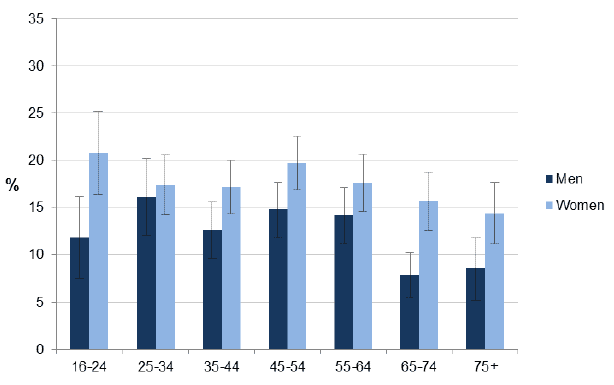
In adults aged 16-24, WEMWBS scores are significantly higher among men than women (mean scores of 51.5 and 48.8 respectively). Men in this age group were also less likely to show signs of the presence of a possible psychiatric disorder, based on General Health Questionnaire responses.
After controlling for the effect of other demographic and health-related factors, age remains a significant predictor of mental health in both the WEMWBS and GHQ12 logistic regression models.
Men in the older age groups (all groups from ages 55+) are significantly less likely to show signs of a possible psychiatric disorder compared to 16-24 year olds. For example, comparing those aged 75+ with the 16-24 group, the odds ratio for signs of a possible psychiatric disorder is 0.36 (CL 0.14, 0.92). Results by age for women are not significant after controlling for other factors.
Table 6B
The same pattern is not evident for below average mental wellbeing (although again results for women are not statistically significant). Men in the age groups from 55+ are not significantly more likely to have a low WEMWBS score compared to adults aged 16-24. However, men aged 25-54 are shown to be more likely to have lower mental wellbeing compared to the 16-24 group. For example, comparing men aged 45-54 with those who are 16-24, the odds ratio for low mental wellbeing is 2.13 (CL 1.20, 3.76).
Table 6A
4.1.2 Marital status
Scores on the WEMWBS scale are lowest among adults whose relationship status is 'separated', with a mean of 45.8. People who are married (51.2) or living as married (50.4) have the highest mean scores. Scores within each marital status category do not vary significantly by gender.
Figure 4C
WEMWBS mean scores, by marital status (not age-standardised), 2012/2013
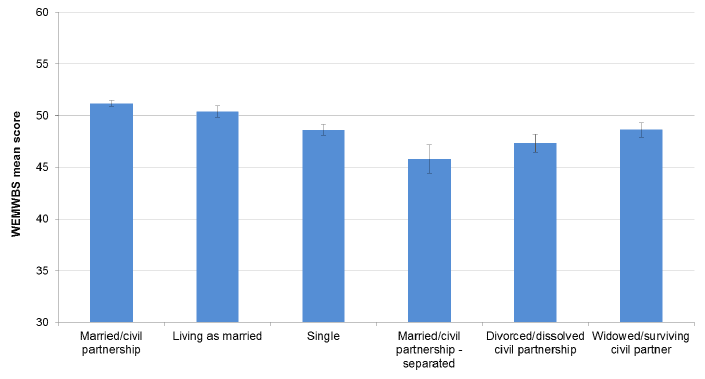
A greater proportion of singles (20%) and separated couples (28%) exhibit signs of the presence of a possible psychiatric disorder, compared to people who are married (12%) or living as married (15%).
Figure 4D
Proportion of adults with GHQ12 scores of four or higher, by marital status (not age-standardised), 2012/2013
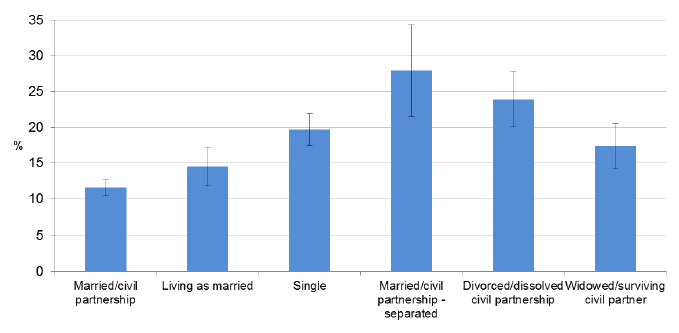
Marital status is a significant factor in the logistic regression model designed to predict below average WEMWBS scores after controlling for other factors. Women who are separated, divorced, widowed or single are all more likely to have a low WEMWBS score, compared to women whose marital status is married/civil partnership (odds ratios of 2.19, 1.94, 1.71 and 1.85 respectively). For men, results indicating low mental wellbeing are strongest among the separated and widowed groups (odds ratios 3.62 and 2.21 respectively) but also marginally significant among singles (odds ratio 1.48; CL 1.01, 2.17) compared to the reference group.
Adults who are not married are significantly less likely to respond positively to the WEMWBS statement, 'been feeling love'. Results are significant for women in all non-married marital status categories, including 'living as married', and for men in all categories except 'living as married'
WEMWBS statement 'Been feeling love': results of logistic regression analysis indicating a low score, by marital status and sex, 2012/2013
| Odds ratio | 95% confidence limits | |||
|---|---|---|---|---|
| Men | Living as married vs Married/civil partnership |
1.00 | 0.79 | 1.26 |
| Single vs Married/civil partnership |
3.63 | 2.92 | 4.51 | |
| Separated vs Married/civil partnership |
5.45 | 3.32 | 8.95 | |
| Divorced/dissolved civil partnership vs Married/civil partnership |
3.68 | 2.68 | 5.04 | |
| Widowed/surviving civil partner vs Married/civil partnership |
2.28 | 1.59 | 3.25 | |
| Odds ratio | 95% confidence limits | |||
|---|---|---|---|---|
| Women | Living as married vs Married/civil partnership |
1.36 | 1.11 | 1.66 |
| Single vs Married/civil partnership |
2.86 | 2.33 | 3.51 | |
| Separated vs Married/civil partnership |
3.21 | 2.15 | 4.80 | |
| Divorced/dissolved civil partnership vs Married/civil partnership |
2.49 | 1.99 | 3.12 | |
| Widowed/surviving civil partner vs Married/civil partnership |
1.99 | 1.60 | 2.48 | |
Single (OR 1.73; CL 1.27, 2.38), separated (OR 1.81; CL 1.07, 3.06), widowed (OR 1.94, CL 1.39, 2.71) or divorced (OR 1.57; CL 1.15, 2.13) women are also more likely than those who are married or in a civil partnership to show signs of the presence of a psychiatric disorder, based on responses to the GHQ12 questionnaire, after controlling for other factors. The equivalent results for men are only statistically significant among the group who are separated (OR 2.15; CL 1.14, 4.02).
Men who are living as married (OR 0.53; CL 0.32, 0.87) are less likely than married men to say they have been losing self-confidence. The opposite is true among women who are living as married, with women in each of the non-married groups more likely to say they have been losing self-confidence.
GHQ component 'Been losing confidence in self': results of logistic regression analysis indicating a low score, by marital status and sex, 2012/2013
| Odds ratio | 95% confidence limits | |||
|---|---|---|---|---|
| Men | Living as married vs Married/civil partnership |
0.53 | 0.32 | 0.87 |
| Single vs Married/civil partnership |
1.06 | 0.74 | 1.54 | |
| Separated vs Married/civil partnership |
1.83 | 0.93 | 3.59 | |
| Divorced/dissolved civil partnership vs Married/civil partnership |
1.00 | 0.56 | 1.81 | |
| Widowed/surviving civil partner vs Married/civil partnership |
1.12 | 0.63 | 1.99 | |
| Odds ratio | 95% confidence limits | |||
| Women | Living as married vs Married/civil partnership |
1.47 | 1.06 | 2.04 |
|---|---|---|---|---|
| Single vs Married/civil partnership |
1.47 | 1.07 | 2.01 | |
| Separated vs Married/civil partnership |
1.91 | 1.12 | 3.25 | |
| Divorced/dissolved civil partnership vs Married/civil partnership |
1.61 | 1.18 | 2.20 | |
| Widowed/surviving civil partner vs Married/civil partnership |
1.92 | 1.38 | 2.66 | |
4.1.3 Scottish Index of Multiple Deprivation (SIMD)
In the 20% least deprived areas in Scotland, the mean WEMWBS score among adults (16+) is 51.8. In the most deprived areas, the mean score is 47.2. Scores decline approximately linearly with increasing deprivation, but with a sharper decline between the second (49.3) and most deprived (47.2) quintiles.
Figure 4E
WEMWBS mean scores, by SIMD quintile, 2012/2013
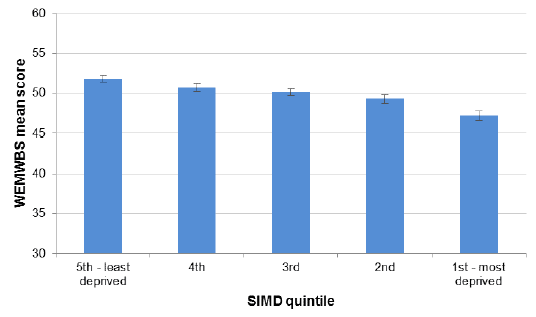
A similar relationship is observed between increasing deprivation and the proportion of GHQ12 scores of four or higher, indicating the presence of a possible psychiatric disorder. The proportion of adults who score four or higher increases with area deprivation. As with WEMWBS, the increase is sharpest between the second (16%) and most deprived (23%) quintiles. The proportion of adults ranges from 12% of those in the least deprived areas to 23% (20% of men; 25% of women) in the most deprived areas.
Figure 4F
Proportion of adults with GHQ12 scores of four or higher, by SIMD quintile, 2012/2013
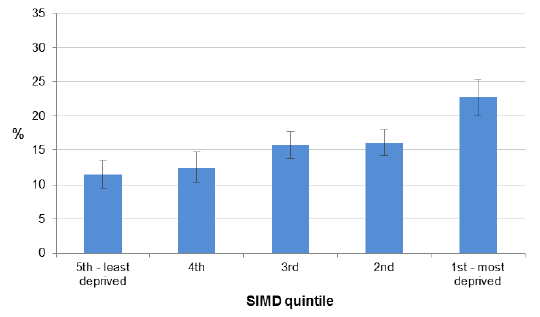
However, once all other factors, such as economic activity, are taken into account, area deprivation is not a significant predictor for GHQ12 scores of four or higher. After controlling for all other factors, the odds of those adults in the 15% most deprived areas having a low mental wellbeing score are not significantly lower than those in other areas.
Many of the health-related factors for which the results indicate an association with poor mental wellbeing - for example, smoking and alcohol dependence - are socio-demographically patterned whereby prevalence is generally higher in the most deprived areas. Therefore, although area deprivation is shown not to be a significant predictor after controlling for other factors, prevalence of some of the most significant risk factors for low mental wellbeing remains highest in deprived areas.
4.1.4 Equivalised household income
A reference person (or their partner) for each household involved in SHeS was asked to state their own (and their partner's) aggregate gross income, and were then asked to estimate the total household income including that of any other persons in the household.
Equivalised income adjusts to take account of the number of persons in the household. Households are then ranked by equivalised income, allowing quintiles to be defined. All individuals in each household were allocated to the equivalised household income quintile to which their household had been allocated.
WEMWBS scores by equivalised household income quintiles follow a similar pattern to the distribution by deprivation quintile. Among those in the highest income quintile, the mean WEMWBS score in 2012/2013 was 51.7, while in the lowest income quintile the mean score was 46.3. Scores did not vary significantly by sex.
Figure 4G
WEMWBS mean scores, by equivalised household income quintile, 2012/2013
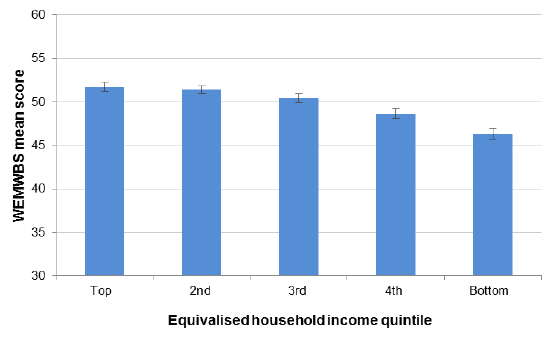
In the top three income quintiles, there is little difference in the proportion of men and women scoring four or more on the GHQ12 scale (8%-12%). However, the proportion increases sharply in the two lowest income quintiles, with 25% of men and 31% of women scoring at least four on the GHQ12 scale in the lowest quintile.
Figure 4H
Proportion of adults with GHQ12 scores of four or higher, by equivalised household income quintile and sex, 2012/2013
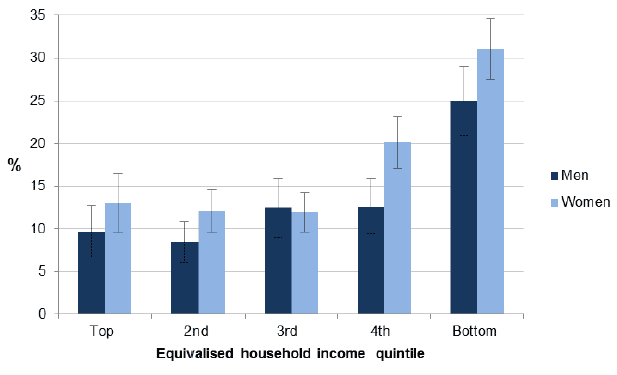
Equivalised household income is a significant factor in the multivariate logistic regression models for below average mental wellbeing and signs of a possible psychiatric disorder.
Women in households below the top income quintile are more likely to have a low WEMWBS score compared to their top income quintile counterparts after controlling for other demographic and health-related factors (odds ratios 1.62, 1.85, 2.84, 2.82 for the 2nd, 3rd, 4th and 5th income quintiles respectively). Results are not significant for men by income quintile.
Results for GHQ12 scores of four or higher also have a stronger association with household income among women than men. However, unlike the pattern for WEMWBS, only those women in the lowest income quintile are statistically significantly more likely to have a GHQ12 score of four or higher compared to those in the highest quintile (OR 1.48; CL 1.04, 2.12).
4.1.5 Urban/ rural classification
Mean WEMWBS scores are higher in rural areas than in urban areas[b], but the difference is not statistically significant. In large urban areas, accessible small towns and other urban areas, mean scores are 49.7, 49.5 and 49.7 respectively. In remote rural areas, accessible rural areas and remote small towns, mean scores are 50.9, 50.7 and 49.9 respectively.
Figure 4I
Figure 4I
WEMWBS mean scores, by urban-rural classification, 2012/2013
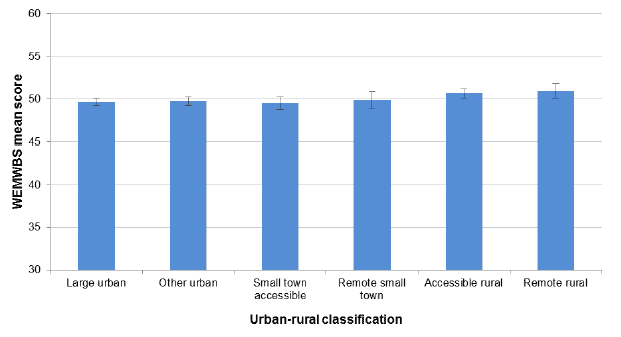
However, there is more variation by urban-rural classification in the proportion of adults scoring four or higher in the GHQ12 measure, indicating the presence of a possible psychiatric disorder, including 17% of those in large urban areas compared to 10% of those in remote rural areas.
Figure 4J
Although these figures are standardised by age to ensure comparability, urban-rural classification does not remain a significant effect once other factors are taken into account in regression analyses.
Figure 4J
Proportion of adults with GHQ12 scores of four or higher, by urban-rural classification, 2012/2013
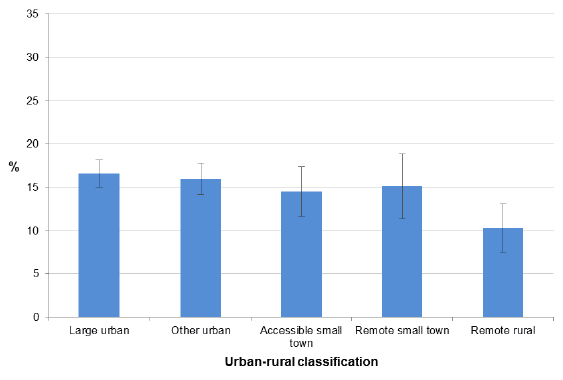
4.1.6 Economic activity
Adults who are permanently unable to work score considerably lower (39.6) on the WEMWBS scale compared to those who are in employment or government training (51.1), full-time education (50.6) or are retired (50.6).
Figure 4K
Due to the considerable differences in the age distribution within each group, for example with very few individuals retired below the age of 40, it is not possible to robustly age-standardise these results, so differences observed in mean scores could in part reflect different age profiles. However, economic activity does remain a statistically significant factor after controlling for other independent variables.
Figure 4K
WEMWBS mean scores, by economic activity category (not age-standardised), 2012/2013
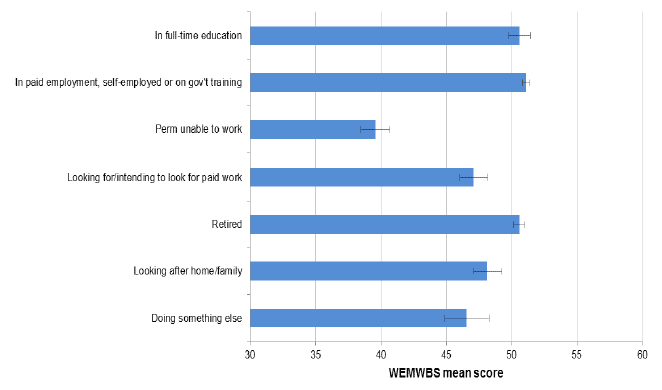
More than half (54%) of adults who are permanently unable to work or looking for work exhibit signs of a possible psychiatric disorder, considerably higher than the proportion among those who are in work (11%), retired (12%) or in full-time education (17%).
Figure 4L
Figure 4L
Proportion of adults with GHQ12 scores of four or higher, by economic activity category (not age-standardised), 2012/2013
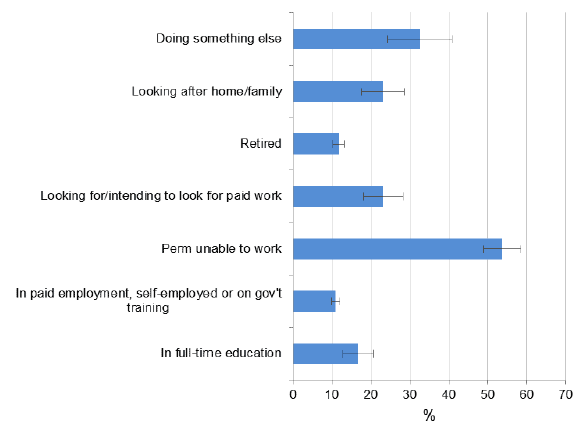
For both WEMWBS and GHQ12, economic activity had the strongest association with low mental health and wellbeing of all factors included in these analyses. Although this may partially reflect the effect of unemployment on mental wellbeing, the results may be confounded by those who are unable to take up work as a result of poor mental health.
Men and women who are permanently unable to work have significantly higher odds (odds ratios 5.09 and 4.85 respectively) of a low WEMWBS score, or a GHQ12 score of four or greater (odds ratios 6.43 and 4.51 respectively) compared to people in paid employment or government training.
Men and women looking after the home also have significantly higher odds (odds ratios 3.15 and 1.63 respectively) of showing signs of the presence of a possible psychiatric disorder compared to those in work. Also, women who are looking for (or intending to look for) work are significantly more likely to score low on the WEMWBS scale (OR 1.74; CL 1.13, 2.67).
Tables 6A and 6B
These results are significant for all twelve GHQ12 components and all fourteen WEMWBS components, underpinning the overall measures, for both men and women who are permanently unable to work. In particular, men and women permanently unable to work are significantly less likely to respond positively to the statements:
- 'been dealing with problems well' (odds ratios 5.51, 4.88)
- 'been feeling confident' (odds ratios 5.82, 5.81)
- 'been able to concentrate' (odds ratios 11.01, 4.46)
- 'felt playing a useful part in things' (odds ratios 8.80, 5.59)
- 'felt capable of making decisions' (odds ratios 6.59, 5.67)
- 'been able to face problems' (odds ratios 7.31, 5.22)
- 'been losing confidence in self' (odds ratios 7.23, 4.78)
- 'been thinking of self as worthless' (odds ratios 9.91, 7.17).
4.1.7 Parental socio-economic classification
Data on socio-economic classification is gathered in the Scottish Health Survey using the National Statistics Socio-Economic Classification (NS-SEC). It is based on occupation, accepted internationally and used widely in the research community. Analysis is possible using the survey respondent's own classification, their (highest) parental classification and the classification for a reference person in the household.
Mean WEMWBS scores are lower among adults whose highest parental socio-economic classification was semi-routine (49.0) or lower supervisory (49.0), compared to managerial and professional (50.9), intermediate (50.9) or small employers / own account (50.6) classifications.
Figure 4M
Similarly, relatively high proportions in these groups (18% and 17% respectively) exhibit signs of the presence of a possible psychiatric disorder, compared to those in other groups (15%, 12% and 13% respectively).
Figure 4M
WEMWBS mean scores, by parental socio-economic classification, 2012/2013
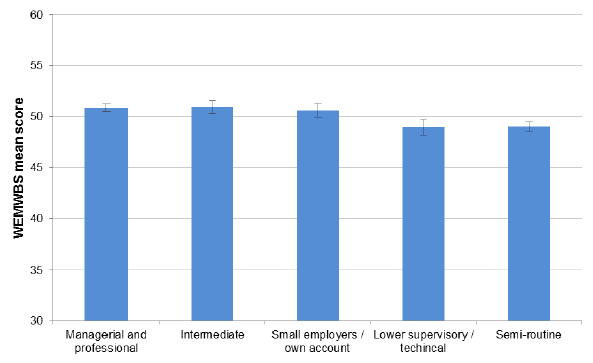
After taking account of other factors, men whose highest parental socio-economic classification was semi-routine are significantly more likely to have a GHQ12 score of four or higher, compared to those in managerial and professional positions (OR 0.66; CL 0.47, 0.92). Respondents' own socio-economic classification is not a significant predictor for either mental health outcome after controlling for other factors including parental classification and other related demographic characteristics which were more strongly correlated with each measure.
Table 6B
4.1.8 Household tenure
The housing tenure question in the Scottish Health Survey asks if the respondent is currently buying their home with a mortgage/loan, owns it outright, rents it or lives rent free. Due to the different age distribution within tenure grouping, it is not possible to reliably age-standardise these results in the manner used for most other topics in this report, so it is possible that differences observed could in part reflect different age profiles by household tenure.
Renters have a mean WEMWBS score of 47.8, considerably lower than among those who are buying with a mortgage or loan (50.8) or own their home outright (51.2). A higher proportion of renters (23%) have a GHQ12 score of four or higher, compared to those buying with a mortgage (13%) or owning their home outright (11%).
However, controlling for the impacts of all of the other factors discussed in this report, including related demographic factors, home ownership is not a significant predictor for low mental wellbeing scores or the presence of a possible psychiatric disorder.
4.1.9 Household type
Mean WEMWBS scores fluctuate considerably by household type, from a high of 51.3 among '2 adult households (no children), one or both of whom are aged 60+', to 46.4 for single adult (aged 16-59) households with no children. The mean for this latter group is considerably lower than all other household types (ranging from 48.9 to 51.3). Results for each household type do not vary significantly by gender.
Figure 4N
Figure 4N
WEMWBS mean scores, by household type (not age-standardised), 2012/2013
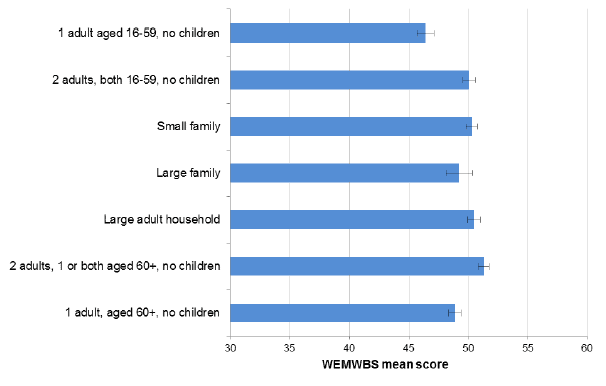
In single adult (aged 16-59) households, 27% display signs of the presence of a possible psychiatric disorder, while, for adults in all other household types, the proportion varied between 11% and 17%.
Figure 4O
Figure 4O
Proportion of adults with GHQ12 scores of four or higher, by household type (not age-standardised), 2012/2013
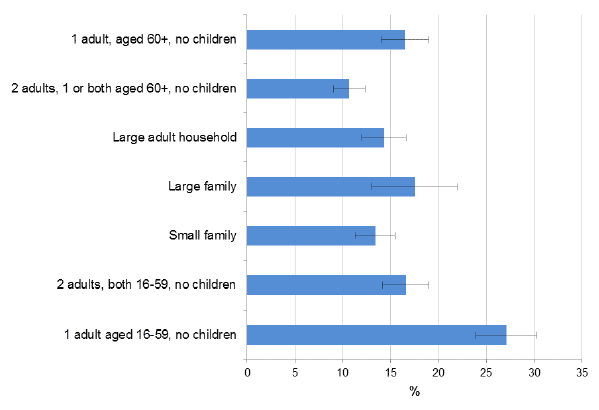
Despite these results, household type is not a significant predictor of low mental wellbeing or the presence of a possible psychiatric disorder after controlling for other explanatory factors, including strongly related demographic factors such as marital status and whether household members regularly eat meals together.
4.1.10 Highest educational qualification
Mean WEMWBS scores increase with increasing highest educational qualification, from 46.4 among respondents with no formal educational qualification, up to 51.9 among those with a degree or higher. Similarly, the proportion of adults exhibiting signs of a possible psychiatric disorder steadily decreases with increasing educational qualifications, from 24% with no formal education to below 12% with a degree or higher.
Although highest educational qualification is strongly correlated with below average mental wellbeing scores, it is also associated with other explanatory factors which have a stronger association with mental wellbeing. Therefore, following tests for variable collinearity, this was not included in final logistic regression models.
4.1.11 Unpaid care
Background
Participants are asked if they look after or give any regular help or support to family members, friends, neighbours or others because of a long-term physical condition, mental ill-health or disability; or problems related to old age. This does not include caring activity done as part of paid employment. Those who do provide unpaid care are then asked how many hours per week they typically provide care. Results in this section are disaggregated by hours of care, but do not include further information gathered in the survey on support to carers, impact on employment or length of time providing care.
In 2012/2013, 17% of adults (15% of men; 19% of women) reported providing unpaid care. Most carers provide less than 35 hours of care per week (30% provide up to 4 hours of care; 45% between 3 and 34 hours; 18% for 35 hours or more and 7% varied levels of care).
Caring prevalence is higher in the middle-upper age groups, with 22% of men and 32% of women aged 55-64; 19% of men and 27% of women aged 45-54; and 19% of men and women aged 65-74 providing unpaid care . This compares to 9% of men and 11% of women aged 16-34, and 12% of men and 9% of women aged 75+. Results below are age-standardised to take account of the age profile of unpaid carers.
Results
Mental wellbeing scores are lower among adults who do provide unpaid care, with lower overall WEMWBS scores as hours of care provided increases.
Among carers who provide support for more than 35 hours per week, WEMWBS scores (46.4) are considerably lower than among non-carers (49.9). However, carers who provide a small amount of care, in particular those who provide up to 4 hours per week, show a higher mean WEMWBS score (51.5) than non-carers, indicating a higher level of mental wellbeing. The mean score among adults who provide between 5 and 34 hours of care per week was 50.4.
Figure 4P
Figure 4P
WEMWBS mean scores, by sex and hours of unpaid care, 2012/2013
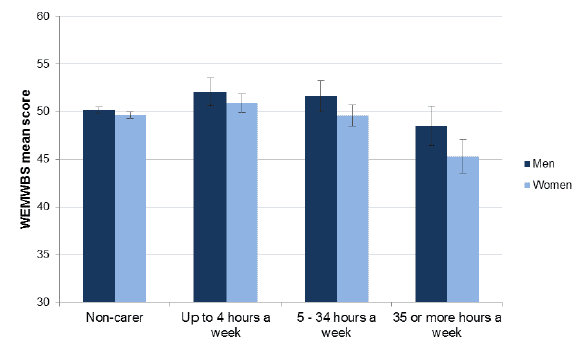
Carers who provide more than 35 hours per week (35%) are significantly more likely to exhibit signs of the presence of a possible psychiatric disorder than non-carers (15%), carers who provide 0-4 hours (10%) or carers who provide 5-34 hours (17%) of care per week. The difference in the proportion exhibiting signs of the presence of a possible psychiatric disorder, comparing carers providing up to 4 hours per week compared to non-carers, is also statistically significant.
Figure 4Q
Figure 4Q
Proportion of adults with GHQ12 scores of four or higher, by sex and hours of unpaid care, 2012/2013
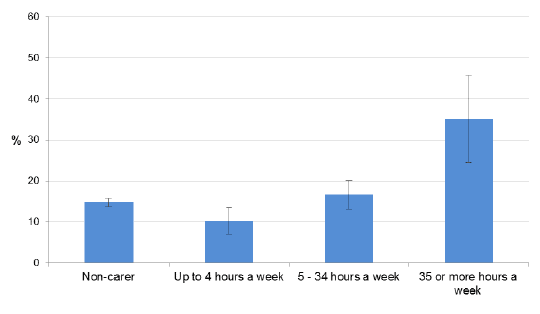
Unpaid caring is a significant predictor of low mental wellbeing and the presence of possible psychiatric disorders after controlling for other related factors described in this report, with results generally stronger among women. Specifically, women who carry out 35 or more hours of unpaid care are more likely to have a low WEMWBS score compared to those who do not provide any unpaid care (OR 2.43; CL 1.56, 3.76). Although the same results are not significant for male carers, in GHQ12, men (OR 2.16; CL 1.29, 3.62) and women (OR 2.76, CL 1.80, 4.25) in an unpaid caring role for more than 35 hours per week have greater odds, compared to non-carers, of having a score of four or higher, indicating the presence of a possible psychiatric disorder. GHQ12 results are also marginally significant among women in a caring role for 5-34 hours per week (OR 1.40; CL 1.01, 1.95).
Tables 6A and 6B
Furthermore, women who provide 35 hours or care or more per week are significantly more likely (OR 2.72; CL 1.94, 3.84) to respond negatively when asked if they have 'been feeling relaxed'. Although results are significant for nine of the fourteen WEMWBS component questions among women, results for 'feeling relaxed' stand out as most notably significant.
4.1.12 Perception of local crime
The perception of local crime is identified in literature as a factor associated with mental health.
Respondents were asked how much they thought local crime had changed in the last two years. This is included as a core survey question in each of the Scottish Government population surveys, including SHeS, to align with the Scottish Crime and Justice Survey.
Results suggest adults who perceive that their local crime is now a lot more than it was two years ago have a lower mean WEMWBS score (45.5) - i.e. have lower mental wellbeing - than those who think it about the same (50.2), a little more (49.5) or a little less (49.2).
Furthermore, of those who think there is a lot more local crime now compared to two years ago there is a markedly increased proportion (32%) exhibiting the presence of a possible psychiatric disorder compared to those who think it has risen a little more (18%) or is about the same (14%).
Contact
Email: Craig Kellock
There is a problem
Thanks for your feedback